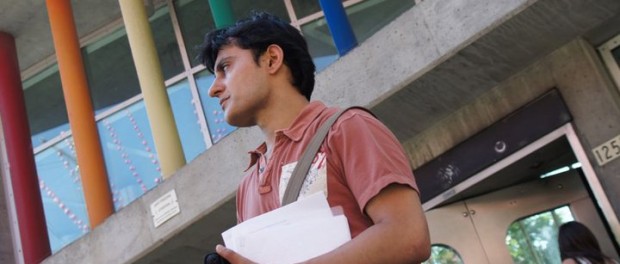Through My Brown Gay Lens #1: Introductions
After quitting my corporate law firm career in India I moved to Montreal, some seven years ago, to make movies. I arrived starry eyed, walking through the old seemingly European-French part of the city, with romantic poetry ringing through my head, taking in the sights and sounds of this interesting city. I marveled at the large church buildings (which I still do, coz most of them around the city remain empty and I find myself sitting alone in them on random Sundays), and the variety of languages I could hear on the subway (though some people would make us believe that Montreal speaks only one language). I began looking for subjects to make my films and I wondered what stories a city like Montreal would want to tell. Would they be out of the blazing Punjabi music in Parc Ex or about families living in pretty manicured town houses on Ile-des-Soeurs? A graffiti artist’s story, whose canvas is indiscriminate walls in the plateau or the rampant homelessness that seems to thrive unnoticed?
My list of subjects and their stories began to grow, but I still wasn’t sure what my first story about Montreal would be. Then someone asked me who I was and where I was from (the typical North American question; one immigrant asking another). That was it! The subject and the narrative had been found, together waiting to be brought to life on celluloid.
The question I was going to ask: where does a queer person of colour fit within the dominant white, blond haired, blue eyed image of the perfect gay man? Was there room for this brown queer immigrant in the larger narrative of LGBTQ Montreal? Is this boy meant to be relegated to the fringe of an already marginalized community and is the brown queer person still invisible in the 21st century? The obvious starting point of this narrative was the Gay Village; the stretch that spans St. Catherine street from Amherst to Ave. Papineau. My research started with the rainbow colours on Metro Beaudry. I visited Priape, walked by Oasis and later G.I. Joe hesitant and half-certain if it was ok to peek inside. There was Parking and the Drugstore (both of which have gone out of business since… sigh) and while I continued to walk around, chit chat with strangers, eavesdrop on conversations, I was still looking for the images that resembled me, possibly even spoke like me. For it wasn’t just the colour of my skin, but also the alien tongue I spoke, that didn’t let me feel like I belonged. I looked and looked, wondering who I was and where I fit. I even took out my moving camera and made a short film of the ‘Faceless’ man who wanted so bad to fit within this stereotype. But alas, that wasn’t meant to be.
In all this hustle bustle of meeting new people like and unlike me, I realized that the gay queer’s search wasn’t going to end soon. The stereotype remains in place and most often perpetuated by ‘popular culture’. I still get blocked on Grindr when I tell people that I am South Asian. I am still the object of the old white male, who looks at me as something exotic, perhaps nothing else.
Even though Montreal’s prodigy Dolan refuses to make films about people like me, I took my queer self and planted it in front of the canvas of Montreal, Simply because this was where my voice finally CAME OUT.”
Sinj Karan is a Montreal based writer and filmmaker.






